|

  
 









































CLICK HERE!
To Find
out More
about Our Award-
Winning DVD:
Mickey Mantle:
The American
Dream Comes
To Life®
®Copyright 1998-2010
Official Mickey Mantle web site
|
|
 |
Mickey Mantle:
The American
Dream
Comes To Life®
The Award-Winning Videography™ Program
& Its Companion Volume
Official
Web Site & Catalog - Featuring Mickey Mantle's Life Story |
 |
|
Mickey Mantle
FAQs
(Frequently Asked Questions about Mickey
Mantle)
Part One
(Excerpted from the award-winning DVD,
Mickey Mantle:
The American
Dream Comes To Life® - The
Deluxe
Lost
Stories Edition
- Mickey Mantle tells his own life story
(autobiography) on DVD.
Click Here
to learn
more about it.
Click Here to see an outline of the contents of the
DVD.) |
|
FAQs #1-10:
1. When was Mickey Mantle born, and where was his birthplace?
Mickey was born on October 20, 1931 in Spavinaw, Oklahoma, located
about 35 miles southwest of the town of Commerce.
 2. What can you tell us about Mickey's family? 2. What can you tell us about Mickey's family?
Mickey was the oldest son of Elvin "Mutt" Mantle and Lovell Mantle. He had
three brothers: twin brothers Ray and Roy and brother Butch, the youngest,
as well as a sister, Barbara. He married hometown sweetheart Merlyn Johnson
on December 23, 1951 and had four sons: Mickey Jr., David, Billy and Danny.
3. How did Mickey become a switch-hitter and such a great home run hitter?
 Mickey's dad, Mutt Mantle, was a great baseball fan. He shared his
love of the game with Mickey. Every day after Mickey came home from school
and Mutt returned from working in the lead mines, he and Mickey's grandfather
Charlie would pitch to Mickey. Mickey batted left-handed against Mutt,
who was right-handed, and right-handed against Grandpa Charlie, who was
a lefty. From an early age Mickey showed tremendous natural talent and
great power from both sides of the plate. It is said that Mutt foresaw
the platooning that later became common in baseball, and that by teaching
Mickey to switch-hit he insured that Mickey would play more in later years. Mickey's dad, Mutt Mantle, was a great baseball fan. He shared his
love of the game with Mickey. Every day after Mickey came home from school
and Mutt returned from working in the lead mines, he and Mickey's grandfather
Charlie would pitch to Mickey. Mickey batted left-handed against Mutt,
who was right-handed, and right-handed against Grandpa Charlie, who was
a lefty. From an early age Mickey showed tremendous natural talent and
great power from both sides of the plate. It is said that Mutt foresaw
the platooning that later became common in baseball, and that by teaching
Mickey to switch-hit he insured that Mickey would play more in later years.
4. I know Mickey had problems with his legs.
How did he originally injure them?
While playing high school football Mickey was accidentally kicked in
the leg. The wound developed into the bone disease osteomyelitis,
and it almost cost Mickey his leg. Mickey's mother refused to let doctors
remove his leg and transferred him to the Crippled Children's
 Hospital
in Oklahoma City, where he received a brand-new wonder drug, penicillin.
It saved his leg. However, Mickey was plagued with leg problems for the remainder
of his life. Hospital
in Oklahoma City, where he received a brand-new wonder drug, penicillin.
It saved his leg. However, Mickey was plagued with leg problems for the remainder
of his life.
5. How did the
Yankees discover Mickey Mantle?
When Mickey was in high school he played baseball with a team called
the Baxter Springs Whiz Kids. New York Yankees' scout Tom Greenwade was sent
to see a teammate of Mickey's named Billy Johnson. In that game Mickey
hit two long home runs into a river that ran behind the ballpark's outfield
fence. Greenwade was so impressed he wanted to sign Mickey with the Yankees
on the spot. Upon finding out that Mickey was still in high school, he
told Mickey that he would come back and sign him right after he graduated
from high school, which is exactly what he did.
 6. When was Mickey's first season with the
Yankees? 6. When was Mickey's first season with the
Yankees?
Mickey's first season with the Yankees was 1951. After a terrific spring
training in Arizona (the Yankees, who regularly trained in Florida, traded
spring training camps with the NY Giants that spring), Casey Stengel talked owners
Del Webb and Dan Topping, and General Manager George Weiss, into signing
Mantle. He even convinced them to pay Mickey a $7,500 salary, $2,500 above
the $5,000 major league minimum.
7. When did Mickey play his first major league
game?
Mickey's first major league game was against
the Boston Red Sox at Yankee
Stadium on April 17, 1951. Mickey played rightfield, where he made three
putouts. At the plate he went 1-for-4 with an rbi single to leftfield in the
sixth, and he scored a run that same inning when Yogi Berra singled to
center.
8. What was Mickey's original uniform number
with the Yankees?
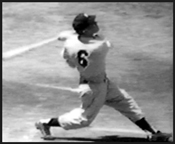 When Mickey first came up with the
Yankees he was given uniform number
six. In photos from the first part of the 1951 season he can be seen wearing
number six. In July of that year, after a particularly horrendous slump,
Casey Stengel sent Mickey down to the Yankees Triple A minor league team
in Kansas City to regain his batting swing. In August Mickey was brought
back up and was given his famous uniform number seven, which had become vacant
while he was away. Seven remained his number for the remainder of his career. When Mickey first came up with the
Yankees he was given uniform number
six. In photos from the first part of the 1951 season he can be seen wearing
number six. In July of that year, after a particularly horrendous slump,
Casey Stengel sent Mickey down to the Yankees Triple A minor league team
in Kansas City to regain his batting swing. In August Mickey was brought
back up and was given his famous uniform number seven, which had become vacant
while he was away. Seven remained his number for the remainder of his career.
9. What was the longest ball Mickey Mantle ever hit?
Mickey's longest measured home run (measured when he hit it)
was hit on April 17, 1953 at Griffith Stadium in Washington, DC. It is
his best-known homer and the home run that coined the term "tape measure
home run." The pitcher was Chuck Stobbs. It traveled 565 feet and was measured
by Yankees' PR Director Red Patterson, who used a measuring tape to determine
the exact distance. This 565-foot home run was the only ball ever hit that cleared the left-field
bleachers at Griffith Stadium in a regular season game in its 32 year history.
However, several other Mickey homers probably went farther. Here are some other notable
Mickey Mantle home runs:
Detroit, 9/10/60 - Mantle unloaded an
incredible home run over the
right-field roof
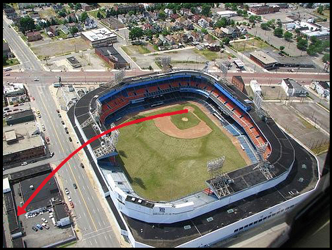 through a light tower (which it may have
grazed) and out
of the park. The pitcher was Paul Foytack. Years later researcher Paul
Susman, Ph.D. found eyewitnesses who confirmed exactly where the
ball landed on the fly. Dr. Susman then measured the distance, which turned
out to be an astonishing 643 feet! This was almost certainly the
longest home run Mickey hit in a regular season game that could actually
be measured to the spot it landed, and probably the longest homer anyone
ever hit in a regular season game that could be measured to the actual
landing point. This 643-foot home run is listed in the Guinness Book of World Records
as the longest homer ever "measured trigonometrically." through a light tower (which it may have
grazed) and out
of the park. The pitcher was Paul Foytack. Years later researcher Paul
Susman, Ph.D. found eyewitnesses who confirmed exactly where the
ball landed on the fly. Dr. Susman then measured the distance, which turned
out to be an astonishing 643 feet! This was almost certainly the
longest home run Mickey hit in a regular season game that could actually
be measured to the spot it landed, and probably the longest homer anyone
ever hit in a regular season game that could be measured to the actual
landing point. This 643-foot home run is listed in the Guinness Book of World Records
as the longest homer ever "measured trigonometrically."
Detroit, 6/18/56
- The Mick walloped a
 tremendous homer over the
right-field roof between the light standard and the end of the upper deck.
The ball went completely out of the park and landed on the adjacent Trumbull
Avenue. It was all the more impressive because it was hit into a stiff wind. Again,
the pitcher was Paul Foytack. (This was the first out-of-the-park
homer Mantle hit off Foytack.) This home run brought about Tigers'
manager Bucky Harris' famous remark, "That would bring tears to the eyes
of a rocking chair." Just two days later Mickey would hit two homers into
the upper deck bleachers in centerfield at Briggs Stadium - something no player had ever
done even once. Both of those home runs landed high above the 400 foot sign in the left-centerfield
bleachers. tremendous homer over the
right-field roof between the light standard and the end of the upper deck.
The ball went completely out of the park and landed on the adjacent Trumbull
Avenue. It was all the more impressive because it was hit into a stiff wind. Again,
the pitcher was Paul Foytack. (This was the first out-of-the-park
homer Mantle hit off Foytack.) This home run brought about Tigers'
manager Bucky Harris' famous remark, "That would bring tears to the eyes
of a rocking chair." Just two days later Mickey would hit two homers into
the upper deck bleachers in centerfield at Briggs Stadium - something no player had ever
done even once. Both of those home runs landed high above the 400 foot sign in the left-centerfield
bleachers.
Detroit, 9/17/58
- Although batting into a stiff wind, Mickey
powered an amazing left-handed home run shot down the rightfield line that
the rocketed high over the right-field roof
at Tiger Stadium (then called Briggs Stadium). The
ball was fair by about 10 feet. It went completely out of the park, crossed
the adjacent Trumbull Avenue
and slammed against the second story of a building on the far side of Trumbull avenue.
A cab driver recovered the ball.
This ball traveled well over 500 feet. Had it not struck the building it would
have ranked as one of Mickey's absolute longest homers. The pitcher for the
Tigers was Jim Bunning.
Baltimore, 8/10/57
- Mickey launched a
 spectacular
and historic home run at Memorial Stadium in Baltimore. He hit
a high, long home run drive that carried well over the the fence in
centerfield and continued on its path past a hedge thirty feet beyond the
centerfield fence. No one in the history of Memorial Stadium
had ever hit a home run that cleared the hedge beyond the centerfield fence,
which was over 460 feet from home plate. Mickey's was the first. The ball traveled well past the hedge
and continued on to an estimated length of 540 feet. It was the longest home
run ever hit to centerfield at Memorial Stadium in Baltimore.
The pitcher for the Orioles was Ray Moore. spectacular
and historic home run at Memorial Stadium in Baltimore. He hit
a high, long home run drive that carried well over the the fence in
centerfield and continued on its path past a hedge thirty feet beyond the
centerfield fence. No one in the history of Memorial Stadium
had ever hit a home run that cleared the hedge beyond the centerfield fence,
which was over 460 feet from home plate. Mickey's was the first. The ball traveled well past the hedge
and continued on to an estimated length of 540 feet. It was the longest home
run ever hit to centerfield at Memorial Stadium in Baltimore.
The pitcher for the Orioles was Ray Moore.
Brooklyn, 10/3/56
- In the first inning of the
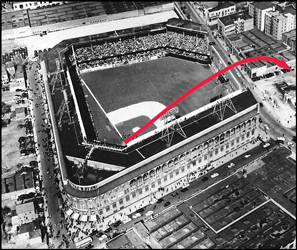 first game of the
World Series against the
Brooklyn Dodgers Mickey crushed a two-run home run that flew high over the right-field screen at
Ebbets
Field. It continued its arc over the neighboring Bedford Avenue and
landed in a neighboring parking lot across the street, where it caused about
$500 in damage when souvenir hunters scrambled over the cars in search
of the home run ball for a trophy. The distance was well over 500 feet. The pitcher
for the Dodgers was Sal Maglie, who went on to win this game
for the Dodgers 6-3. Maglie is better known as the losing pitcher in
Game 5 of the 1956 World Series on October 8, 1956, when Don Larsen
pitched his perfect game at Yankee Stadium. first game of the
World Series against the
Brooklyn Dodgers Mickey crushed a two-run home run that flew high over the right-field screen at
Ebbets
Field. It continued its arc over the neighboring Bedford Avenue and
landed in a neighboring parking lot across the street, where it caused about
$500 in damage when souvenir hunters scrambled over the cars in search
of the home run ball for a trophy. The distance was well over 500 feet. The pitcher
for the Dodgers was Sal Maglie, who went on to win this game
for the Dodgers 6-3. Maglie is better known as the losing pitcher in
Game 5 of the 1956 World Series on October 8, 1956, when Don Larsen
pitched his perfect game at Yankee Stadium.
Yankee Stadium, 6/21/55
- In the first inning against
the Kansas City Athletics. Alex Kellner, a lefty, tried
throwing Mickey a change-up. Batting right-handed, Mickey laid into it and
absolutely hammered it. The ball took off on a bullet-like line drive path
that shot past Kellner's ear and continued to rise until it shot over the
30-foot high centerfield screen near the 461-foot sign. It smashed into a
seat in the ninth row of the bleachers, 486 feet from home plate. No one -
not Babe Ruth, not Joe DiMaggio, not Lou Gehrig, not Hank Greenberg nor
Jimmy Foxx - had ever hit a home run into the centerfield black seats at
Yankee
Stadium. Hitting a ball into the centerfield black seats was the Holy
Grail of Yankee Stadium and another first for Mickey
Mantle. Observers said that the sound that Mickey's bat made when he hit the
ball was like an explosion. Jackie Farrell of the Yankees PR staff manages
to get the ball from the fan who caught it, Oscar Alonso, and after some
negotiating is able to send it to the Baseball Hall of Fame.
Yankee Stadium, 5/30/56
- Mickey
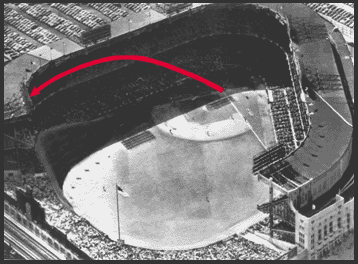 belted his first shot
to hit the façade in right-field. While no ball ever went out of Yankee Stadium during a game, this one missed by only 18 inches or less.
The pitcher was Pedro Ramos. It is believed that Mickey twice jacked balls
out of Yankee Stadium in right-field during batting practice and once even
cleared the left-field seats in batting practice. If true, these were among
the most epic shots in the history of the game. This was the first of five home
runs Mickey hit in his career that struck the façade at Yankee Stadium.
It's not likely that any player will ever equal that total. belted his first shot
to hit the façade in right-field. While no ball ever went out of Yankee Stadium during a game, this one missed by only 18 inches or less.
The pitcher was Pedro Ramos. It is believed that Mickey twice jacked balls
out of Yankee Stadium in right-field during batting practice and once even
cleared the left-field seats in batting practice. If true, these were among
the most epic shots in the history of the game. This was the first of five home
runs Mickey hit in his career that struck the façade at Yankee Stadium.
It's not likely that any player will ever equal that total.
Yankee Stadium, 5/22/63
- "The
hardest ball I ever hit was at Yankee Stadium in
1963." - Mickey Mantle.
Mickey pulverized a ball that rocketed through the night toward the upper
reaches of Yankee Stadium. Yogi Berra, thinking the ball was going out
of the park, cried out, "This is it!" Players from both teams jumped off
their benches to watch
 history be made. But the ball struck the right-field
façade just inches from the top. Mickey hit it with so much force
that after slamming into the cement façade it ricocheted all the
way back to the infield on the fly. The pitcher was Bill Fischer of the
Kansas City A's. Mathematicians have calculated that, had the ball not
struck the Yankee Stadium façade, it would have traveled at least 620 feet. This
distance assumes the ball was at its apex when it hit the façade,
and eyewitnesses are in unanimous agreement that the ball was still rising.
Therefore, 620 feet is the low end distance estimate. A computer projection
calculated that (had the ball not been obstructed by the façade)
it would have been an astronomical 734-foot home run! history be made. But the ball struck the right-field
façade just inches from the top. Mickey hit it with so much force
that after slamming into the cement façade it ricocheted all the
way back to the infield on the fly. The pitcher was Bill Fischer of the
Kansas City A's. Mathematicians have calculated that, had the ball not
struck the Yankee Stadium façade, it would have traveled at least 620 feet. This
distance assumes the ball was at its apex when it hit the façade,
and eyewitnesses are in unanimous agreement that the ball was still rising.
Therefore, 620 feet is the low end distance estimate. A computer projection
calculated that (had the ball not been obstructed by the façade)
it would have been an astronomical 734-foot home run!
Bovard Field, University of Southern California, 3/26/51
-
In an exhibition game during a pre-season barnstorm tour of the west coast,
Mickey blasted two long homers in the
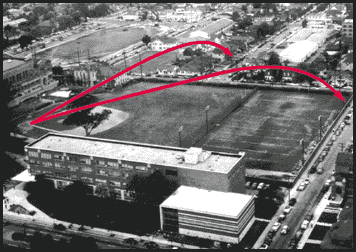 same game, one righty (it went out
of the park, across a street and landed on the roof of a three-story house
several houses down the street, a distance over 600 feet) and one lefty.
The left-handed homer is a legendary shot that may well be the longest
homer ever hit anywhere by anyone. It cleared the right-centerfield wall,
crossed an adjacent football field, and landed 656 feet from home plate
on the fly. This home run is well documented with two eye-witnesses (the
USC center fielder, Tom Riach, and legendary USC Coach Rod Dedeaux). Both
walked out (separately) after the game and pointed to the spot the ball
landed. The two spots they pointed to were only a few feet apart. The photo of this home run (and many others)
is in the film,
Mickey
Mantle: The American Dream
Comes To Life®,
as well as the film's companion volume with the same name, and in the
1998,
1999 and 2000 This Day in Mickey Mantle History® Photo Calendar
- Fact Books. same game, one righty (it went out
of the park, across a street and landed on the roof of a three-story house
several houses down the street, a distance over 600 feet) and one lefty.
The left-handed homer is a legendary shot that may well be the longest
homer ever hit anywhere by anyone. It cleared the right-centerfield wall,
crossed an adjacent football field, and landed 656 feet from home plate
on the fly. This home run is well documented with two eye-witnesses (the
USC center fielder, Tom Riach, and legendary USC Coach Rod Dedeaux). Both
walked out (separately) after the game and pointed to the spot the ball
landed. The two spots they pointed to were only a few feet apart. The photo of this home run (and many others)
is in the film,
Mickey
Mantle: The American Dream
Comes To Life®,
as well as the film's companion volume with the same name, and in the
1998,
1999 and 2000 This Day in Mickey Mantle History® Photo Calendar
- Fact Books.
Houston Astrodome,
4/9/65
-
In an exhibition game played before the start of the 1965 season, the
Yankees went to Houston to play the Houston Astros in
the first game in the first indoor baseball stadium in the world - the
Houston Astrodome. It was not only the first indoor ballpark,
it later sported artificial grass that came to be known as "astroturf."
 However,
on April 9, 1965 the Astrodome had a field of Bermuda grass.
Judge Roy Hofheinz, owner of the Astros, decided to christen
the new ballpark - nicknamed "The Eighth Wonder of the World" - with
an exhibition game against the Yankees. It was hoped the
Mickey Mantle might hit a home run during the game and - possibly - the
first home run ever in an indoor stadium. Mickey did not disappoint.
Although injured, manager Johnny Keane put Mickey into the lineup in the
first position. Leading off in the first inning for the Yankees,
The Mick lined the second pitch of the game into centerfield
for a single for the first hit in Astrodome history. Then,
leading off in the sixth, he slammed a majestic drive deep into the
centerfield stands near the 406 foot marker for a thunderous home run. As
Mickey limped around the bases the crowd cheered him as if he were one of
their own. In the photo to the right Mickey awaits the pitch from Turk
Farrell that he belted for the first home run ever hit in the Houston
Astrodome. However,
on April 9, 1965 the Astrodome had a field of Bermuda grass.
Judge Roy Hofheinz, owner of the Astros, decided to christen
the new ballpark - nicknamed "The Eighth Wonder of the World" - with
an exhibition game against the Yankees. It was hoped the
Mickey Mantle might hit a home run during the game and - possibly - the
first home run ever in an indoor stadium. Mickey did not disappoint.
Although injured, manager Johnny Keane put Mickey into the lineup in the
first position. Leading off in the first inning for the Yankees,
The Mick lined the second pitch of the game into centerfield
for a single for the first hit in Astrodome history. Then,
leading off in the sixth, he slammed a majestic drive deep into the
centerfield stands near the 406 foot marker for a thunderous home run. As
Mickey limped around the bases the crowd cheered him as if he were one of
their own. In the photo to the right Mickey awaits the pitch from Turk
Farrell that he belted for the first home run ever hit in the Houston
Astrodome.
Mickey hit many
more legendary home runs, with shots that went out of ballparks in Pittsburgh,
Washington, Cleveland, Detroit, St. Louis, Los Angeles, Philadelphia, Brooklyn,
Chicago, Baltimore, Kansas City, Boston and others.
10. What was Mickey 's biggest contract with the
Yankees?
 Mickey's largest contract with the
Yankees was for $100,000. At the
time he signed it in 1963 only Joe DiMaggio had received that much before.
Mickey continued to play for that amount for the remainder of his career.
Mickey, a very humble man, felt that it would be disrespectful of Joe
DiMaggio for him to make more money than Joe. Naturally the Yankees were
happy to oblige Mickey's stance. Mickey's largest contract with the
Yankees was for $100,000. At the
time he signed it in 1963 only Joe DiMaggio had received that much before.
Mickey continued to play for that amount for the remainder of his career.
Mickey, a very humble man, felt that it would be disrespectful of Joe
DiMaggio for him to make more money than Joe. Naturally the Yankees were
happy to oblige Mickey's stance.Of
course, that was in the days when the "reserve clause" was included
in every player's contract, thereby preventing players from moving to a
different team without the consent of their current team. It had the effect
of holding down salaries, preventing players from negotiating fair market
value. Curt Flood was the first player to mount a legal challenge against
the reserve clause, in 1969. The Supreme Court ruled to "stand by things
ruled" (stare decisis) and left the reserve clause intact. His
courageous stance brought baseball's anti-labor stance into the public eye.
In 1975 pitchers Andy Messersmith and Dave McNally again challenged the
reserve clause, this time in arbitration,
 and
they were victorious. the way for other players to challenge it in the
future. and
they were victorious. the way for other players to challenge it in the
future.
When asked what he
thought he would make if he were playing now, Mickey said he liked what Joe
DiMaggio said. Joe said that, if he were playing now, he would go up and
knock on the door at Yankee Stadium. When Mr. Steinbrenner opened the door
he would say, "Howdy partner!"
© Copyright 1998 - 2010 - Lewis Early - All Rights Reserved |
|
We highly recommend
Mickey's Videography™
Program:
Mickey Mantle:
The American Dream Comes
To Life®
The Deluxe
Lost Stories
Edition
(2 hours)
Now on DVD
with nearly 200 on-screen pages of bonus features!
"The best baseball program ever made!"
- USA Today, The Washington Post, The NY Daily News, Newsday, The Los
Angeles Times, The TODAY Show, ESPN, Larry King Live... |
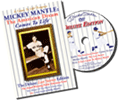
Click Here for Details! |
|
We also
recommend the second Videography™
Program
in the Comes To Life®
Program Series:
John
Madden: The American Dream
Comes To Life®
(1
hour)
Now on DVD! The original program in its entirety -
not one frame has been omitted.
"60 delightful minutes
- A must!"
- USA Today, The Washington Post, The
Oakland Tribune, The San Francisco Chronicle, The Sacramento Bee, The TODAY Show, ESPN... |

Click Here for Details! |
© Copyright 1998-2010 - Lewis
Early
All Rights Reserved |